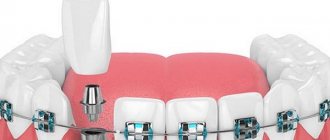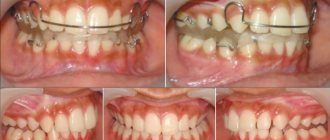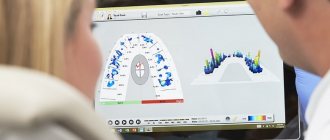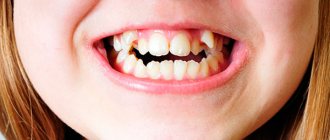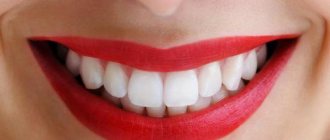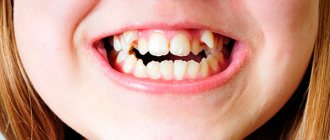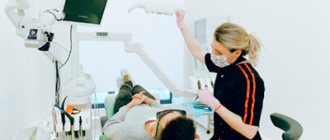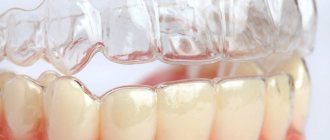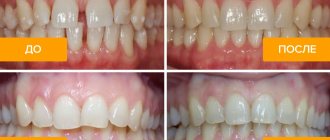What are dental plates?
An orthodontic plate for teeth is a removable structure made of soft plastic and wire. This device is made individually from hypoallergenic materials and is not traumatic to the oral mucosa. Plates for straightening teeth can be either single- or double-jawed, depending on the diagnosis. They can be supplemented with a “hand-shaped process”, which is used to move only one tooth. The device may also contain a retraction arch designed to correct the position of the front teeth. Separate types of plates for teeth are Brückle and Frenkel devices. Look at the photo below to see what the plate looks like on your teeth.
Types of dental plates
Depending on the diagnosis, the doctor determines the types of dental plates. In some cases, only a plate is installed for the teeth of the lower jaw. This design refers to mechanically operating devices, that is, its action depends on the elasticity of the component parts. They use the force of an orthodontic screw, wire, ligature, or rubber ring. To increase space in the dentition at the stage of mixed dentition, an expanding plate for the teeth of the upper jaw, based on a Bertoni screw, is also used. The screw is installed on the working model of the jaw in the deep part of the dome of the palate so that it is parallel to the occlusal plane. This design needs to be tightened from time to time; we will tell you how to do this a little later.
Plastic surgery for lower jaw teeth
Upper jaw plate
Current promotions!
Implantation in installments regularly
The promotion operates regularly and applies to patients who require implantation.
In childhood, dental plates are used both on baby teeth and in mixed dentition, that is, during the period when baby teeth began to change to permanent ones. During adolescence, orthodontic plates are also used for orthodontic treatment. Indications may be the presence of gaps between teeth, incorrect position, insufficient jaw size and other pathologies.
Orthodontist's office at the dental clinic Our Dentist in Krasnogorsk
(images are clickable)
How are plates on teeth arranged?
Plate orthodontic appliances are made of special plastic and a metal part made of medical steel. The lamellar apparatus can be simple or complex, depending on the type and function. The dental plate may have screws, locks, rings and other elements.
Dental plates for adults and children are always made individually. After the orthodontist conducts an examination, an impression will be taken and a special model of the jaws will be cast. The plate apparatus will be manufactured in a specialized laboratory based on the patient’s individual cast.
During the appointment, the orthodontist explains to the patient how to put the plate on the teeth, how long to wear it, how often the device can be removed, and how to care for it.
Compliance with the doctor’s recommendations is the main key to successful treatment and correction of the bite.
During the treatment process, regular doctor examinations are necessary to carry out corrections, activate the device and monitor the ongoing treatment.
If the plate is broken, bent or cracked, you should immediately consult a doctor, since the use of such a device may not only be useless, but also cause harm .
The dental plate can be used both for wearing on one jaw and on both.
How does a plate straighten teeth?
The metal arc of the plate apparatus exerts the necessary pressure, gradually moving the teeth in the desired direction. During the treatment process, the doctor adjusts the device to change the degree of pressure, adjust the compression force, and direct the desired action.
Dental plate for adults and children
The purpose of dental plates is different. For example, mechanical ones are used to correct crooked teeth. Functional plates on teeth affect the muscular system, normalizing their tone and development. Combined devices combine mechanical and functional action.
How much does a dental plate cost?
The price of a dental plate depends on its type. The complexity of the device and the number of additional elements are determined by the doctor. The production of the device in the laboratory is always individual. The price of a simple removable plate is 9,000 rubles, a more complex one is about 12,000.
Installation and activation of the device is carried out by an orthodontist.
How much does a dental plate cost for children?
The prices for dental plates for children do not differ from the cost of devices for teenagers, since they are structurally identical.
Only a doctor can tell you the exact cost of the plate, since all devices are different. The number of certain necessary elements of the apparatus depends only on the condition of the oral cavity, the inclination of the teeth, the angle, curvature, the degree of development of muscles, teeth, gums and other nuances.
Video materials of Dr. Yakushina E. S.
Plates for teeth in Krasnogorsk
In dentistry, our dentist corrects bites using plates. Sign up for a FREE consultation.
Prices shown are valid at the time they are posted on the website and may change over time. Please check with the administrator by phone for the current cost.
Examples of our work
(images are clickable)
Your calls are always welcome! 8 915-367-04-47 - call, make an appointment, come for a free initial consultation, and Our Dentist will become yours!
Dear patients! All prices on the site are valid only at the time of publication. The specialist will inform you about the exact cost and scope of necessary procedures after consultation.
Author of the material: orthodontist Ekaterina Sergeevna Yakushina.
When should a plate be placed on a child’s teeth?
The dental plate is not suitable for adult patients. This is an exclusively children's orthodontic device. First of all, plates for straightening teeth in children are used up to 12 years of age. During this period, there is active growth of the jaws, which makes it possible to quite effectively correct the bite, eliminate crowding and remove other occlusion anomalies. When the jaw bones have formed, it is only possible to align the teeth within the dentition. And correction of bite in adult patients is only possible with the help of braces and orthognathic surgery. In this regard, parents should not delay visiting a specialist, even if it is a preventative one, if treatment is not required. Orthodontists recommend placing a plate on a child’s teeth to achieve the following treatment goals:
- correction of jaw shape;
- regulation of jaw growth;
- correct placement of incisors in a row;
- increasing or decreasing the size of the sky.
Benefits of orthodontic plates
Although bite plates are only effective for minor malocclusions, they have a number of other benefits:
- Convenient to use. The design of the plates allows you to easily and quickly remove them while eating or brushing your teeth;
- Prompt production. The average production time for plates is from 2 to 4 weeks. At the same time, a removable type structure is manufactured faster than a non-removable one;
- Affordable price. The average price of a plate for correcting a bite is 2 times lower than the price of inexpensive braces.
How to place a plate on a child’s teeth?
Installing plates on children's teeth usually takes several weeks, since they are made individually for each patient. To create a suitable orthodontic appliance, the patient undergoes an X-ray examination, then the doctor takes an impression of the teeth for the plate. After this, plaster models are made, from which the structures are created. Particular attention is paid to the exact match of the surface relief of the gums and the palate - the adjustment takes just over 10 minutes. After this, the child will be able to independently remove and put on the plate on the lower teeth and upper jaw.
How much does a removable plate cost and what does its price depend on?
The cost of a removable plate for a child’s teeth depends on the following factors:
- the nature of the pathology that needs to be corrected;
- number of screws on the plate;
- the need for additional dental treatment at the dentist after wearing a corrective plate.
The approximate price of a removable plate for a child’s teeth with one screw included is from 20 thousand rubles, with two or three screws – from 24 thousand rubles. In addition, you need to purchase a storage solution, care products, and a storage box - about another 3 thousand rubles.
You can get a full consultation on installing a plate for children’s teeth from a dentist at the Zuub clinic, which specializes in pediatric orthodontics.
How long do you wear plates on your teeth and how to wear them?
The main problem with this type of treatment is that children need to wear removable dental plates 22–23 hours a day. The course of treatment can last from a year to a year and a half, with replacement of the structure required every 6 to 8 months. Like any orthodontic device, plates for baby teeth require some getting used to. Children often complain that their teeth hurt from the plate; this is normal. Usually the discomfort disappears 5 to 6 days after installation.
Wearing dental plates often confuses children, but it is worth explaining to the child that they are less noticeable and more comfortable than metal braces, which will have to be worn in adolescence without timely treatment. Children's dental plates are often made of plastic in bright colors so that the child enjoys wearing them.
What are orthodontic plates
Orthodontic plates, as a rule, are removable structures that have a base made of soft plastic, as well as metal elements - hooks, arches, springs and screws. They are created in such a way that the base fits tightly to the palate or gums, and metal clamps securely hold the structure in the mouth.
The most key element of such plates is the screw, which is located in the center of the polymer base. It is this that ensures the adjustment of the size of the device, as well as the force of pressure on the teeth and jawbone. Due to this, you can significantly expand the jaw and at the same time shift some of the teeth, or, on the contrary, reduce the size of the jaw. In this case, the hooks act as a retainer for the entire structure, and the metal arch allows you to fix the teeth in a certain position.
Expert opinion
Rustamova Gunel Bakhmanovna Dentist-orthodontist Work experience 4+
“Dental plates are ineffective in correcting serious dental problems. For example, with the help of such a system it will not be possible to get rid of an open bite or severe crowding. Sometimes the production and wearing of a plate can only be the initial stage of treatment, followed by the installation of braces, both in children and adult patients.”
Indications
- correction of the shape of the lower or upper jaw,
- slowing or accelerating the development of the jaw, the growth of some teeth,
- keeping teeth in correct position,
- change in the position of the incisors,
- stretching or narrowing of the palate,
- use as a retention device to consolidate the results of treatment with braces,
- The best effect is achieved in children during the transition from primary to permanent dentition.
Types of structures
- classic plates: equipped with hooks and metal arches, used to correct the position of teeth,
- plates with active screws for expanding or narrowing the jaws,
- plates to protect against bad habits,
- plates with artificial teeth that compensate for dental defects.
Among the disadvantages of the plates is low comfort during treatment. You must be prepared for the fact that they will cause severe speech impairment. Many parents note that children have a strong desire to take off the device and not put it on again. However, this disadvantage is compensated by the fact that the plates do not need to be worn all the time and can be removed for meals and hygiene procedures.
Installation stages and getting used to records
The production of dental plates is less difficult than the production of other orthodontic systems. However, from the moment of diagnosing the condition of the bite to the immediate fixation of the device on the teeth, about a couple of weeks pass - this time is required for the development and fitting of the design.
Production and fixation of plates:
- diagnosis of occlusion condition,
- taking impressions, creating a jaw model that allows you to simulate the process of orthodontic treatment,
- manufacturing of the device,
- trying on the plate - it is important that it fits tightly to the palate, gums and teeth, but does not rub the mucous membranes and does not cause pain,
- adjustment and fixation of the device.
The plates need to be worn from 3-4 hours a day to a full day - it all depends on the degree of pathology and the need to influence the jaw system. The plates are removable devices, so they can be removed for meals and hygiene procedures. These devices require strict self-control - they must be worn for a strictly allotted time, otherwise the treatment will not have a positive effect.
Getting used to the device:
In the first days, wearing the plates may be associated with minor inconveniences - speech may be impaired, there may be a feeling of a foreign body in the mouth. This is absolutely natural and after a few days even the smallest patient adapts to the device, ceasing to feel discomfort. As a rule, dental plates cannot be felt within three to five days after installation.
How to tighten a dental plate?
The twisting procedure is necessary to increase the load, as well as expand the main surface of the plate, which is installed on the upper jaw. Your doctor will tell you how to tighten the dental plate and how often to do it. The process itself is not too complicated: using a key inserted into the main hole of the screw, one turn is made along the guide arrow on the tooth plate. After this, the child may feel discomfort for some time, but this procedure is necessary to achieve the desired result. In addition, if necessary, the plate can be returned to its previous position by turning back.
Dental plastic with a key for twisting
Installation of plates
Installing the plates is a fairly quick, painless process that takes no more than 10 minutes. Most of the time is spent on final adjustment of the system. That is why the first installation of removable plates is carried out in the presence of the attending physician. The doctor will give detailed instructions on the rules for its use, care and how to properly regulate the tension of the arc. The first correction is carried out after the appearance of a visible result - it is this that determines the subsequent course of treatment and its duration. It is important to understand that at first the plate will be perceived as a foreign body in the mouth, which can cause discomfort, impaired diction and increased salivation. The adjustment period averages up to one week; after this the structure ceases to be felt.
How to care for a dental plate?
When wearing a removable structure, the child needs to handle it carefully and avoid damage or loss, as well as properly care for it. You need to remove the plate from your teeth before each meal and be sure to clean it every day with a special brush and gel. It is better to store records in a container. Particular attention must be paid to the little patient’s own oral hygiene. That is why dentists usually give a short lecture to the child, in which they explain all the rules for handling this structure.
Container for dental plates
Plates or braces for teeth?
This choice cannot stand - dental plates and braces have different functions. The former affect the entire dentition, the latter have a wide range of functions and solve various orthodontic problems: from the curvature of individual teeth to malocclusion and crowding. Also, the plate cannot be placed if the child has developed traumatic periodontitis, in which a fracture of the cortical plate of the tooth is possible. However, these two devices can be used in combination - first the child will be given a plate, and then braces.
When does a child need bite treatment?
A removable plate helps with malocclusion, and the causes of these pathologies can be:
- hereditary predisposition;
- problematic pregnancy, deficiencies in the mother’s body (the rudiments are formed in the prenatal period);
- previous removal of baby teeth due to extensive carious lesions;
- the absence of one or more teeth due to injury;
- accelerated eruption of molars (when teeth erupt faster than the jaw develops);
- “bad childhood” habits (thumb sucking, toys, lip biting);
- long-term wearing of a pacifier and artificial feeding;
- diseases of the ENT organs (when a boy or girl breathes through the mouth, while the correct breathing is nasal, the so-called “Gothic palate” develops, adenoiditis and other pathologies);
- initially anatomically compact jaw size.
Also, among the causes of malocclusion in children, there may be a deficiency of solid foods in the diet (when soft, refined foods predominate).
The cost of a dental plate in Moscow
The average cost of dental plates for children in Moscow varies from 8 to 15 thousand rubles. Do not forget that the design requires periodic correction and replacement, so visits to the doctor must be included in the total cost. You should also take into account other factors that affect the price, for example, the level of pediatric dentistry and the qualifications of specialists. In any case, you shouldn’t go after cheapness; the cost of dental plates for children should not be too low - the child’s health is more expensive.
